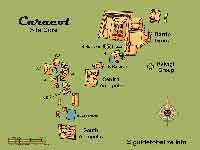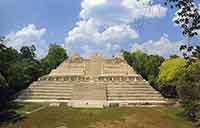Land of the Maya
Caracol


The Mayan ruins of Caracol are the most extensive in all of Belize. After a victory over Tikal in the 6th century, Caracol flourished and became one of the largest Mayan cities. After its decline, the city lay hidden in thick, high-canopy jungle for centuries until a native logger came across the ruins in 1937. A year later two archaeologists visited the ruins. They named the site Caracol, Spanish for Snail, because of the large number of snail shells they encountered.
The earliest habitation of Caracol occurred between 900 BC and 600 BC, while the first Mayan temple, the Temple of the Wooden Lintel, dates from around 70 AD. The Caracol royal dynasty was founded in 331, and the city rose in power over the next two centuries.
At first, Caracol was an alley of Tikal as witnessed by the appointment of a new lord over Caracol by Tikal’s king Double Bird in 553 AD. The relationship between the former allies turned hostile however when Caracol switched alliances from Tikal to Calakmul. An outraged Double Bird declared war against Caracol and defeated it, but not decisively. In 562, Lord Kan (Water) of Caracol, alongside its ally Calakmul planned a war in accordance with astrology against Tikal. Double Bird, was captured and sacrificed and Caracol experienced a boost in wealth and power.

At its peak, Caracol maintained a population of over 140,000 people through the creation of an immense agricultural field system and through elaborate city planning. It covered an area much larger than present day Belize City and may even have exceeded that of Tikal.
During latter reign, Caracol carried out a series of attacks on another former Tikal ally, Naranjo with mixed success. A period of decline followed due to Tikal’s resurgence and the downfall of Calakmul and its alliance. Caracol returned briefly as a major power around 800 AD during the reign of K’inich Joy K’awiil, who resumed both royal monuments dedications and construction activities.
The Last recorded date at Caracol is 859 AD found on Stela 10. Evidence points to a great fire around 895 AD. Its inhabitants eventually dwindled away until the city was finally abandoned around 1050.
